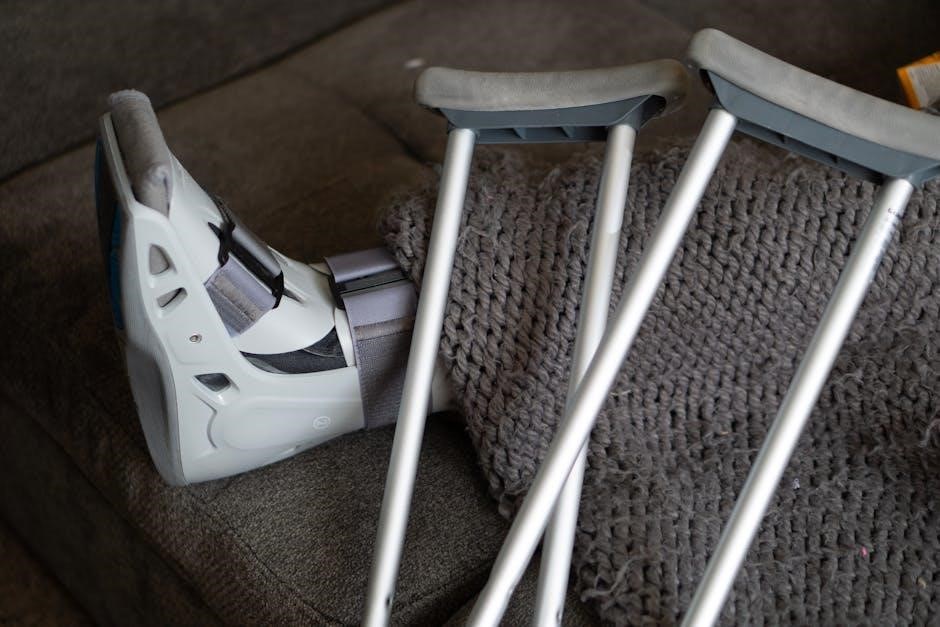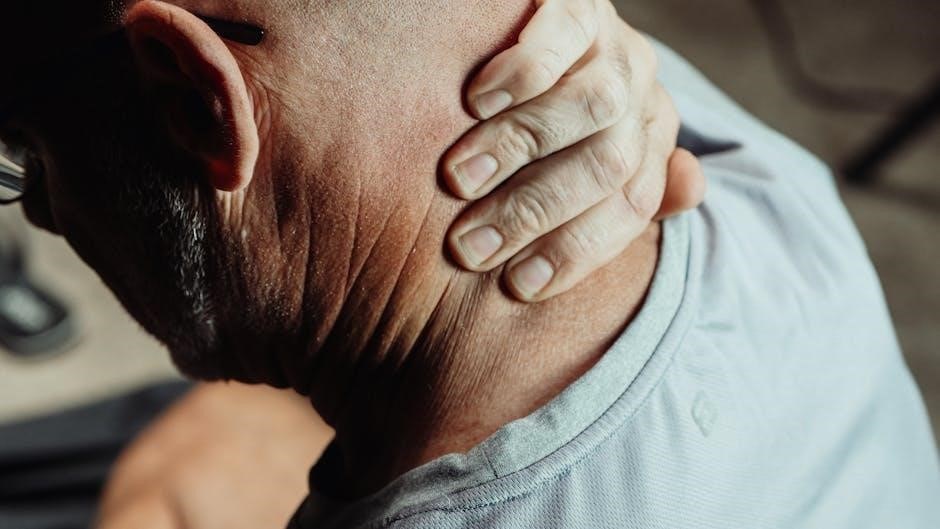
tibia/fibula fracture rehabilitation protocol pdf
The tibia/fibula fracture rehabilitation protocol pdf is a guide for patients
- and healthcare professionals, providing a structured rehabilitation program with illustrations
and images, making it easy to follow and understand the protocol steps clearly always
Overview of the Protocol

The tibia/fibula fracture rehabilitation protocol pdf provides a comprehensive guide for patients and healthcare professionals, outlining the steps necessary for a successful recovery․ The protocol is designed to be easy to follow, with clear illustrations and images that demonstrate each exercise and step of the rehabilitation process․
The protocol begins with an introduction to the rehabilitation process, explaining the importance of following a structured program to ensure proper healing and recovery․ It then breaks down the rehabilitation process into a day-by-day guide, starting from the day after surgery and continuing until the patient is able to bear full weight on the affected leg․
- The protocol includes a range of exercises and activities, such as stretching, strengthening, and mobility exercises, all designed to promote healing and improve function․
- Each exercise is clearly described and illustrated, making it easy for patients to understand and follow the protocol․
- The protocol also includes guidance on pain management, wound care, and other important aspects of recovery․

Overall, the tibia/fibula fracture rehabilitation protocol pdf provides a valuable resource for patients and healthcare professionals, helping to ensure a successful and speedy recovery from a tibia or fibula fracture․
Importance of the Protocol
The tibia/fibula fracture rehabilitation protocol pdf is a crucial tool for ensuring a successful recovery from a tibia or fibula fracture․ By following the protocol, patients can minimize the risk of complications and promote proper healing․
The protocol is important because it provides a structured and guided approach to rehabilitation, which can help patients to regain strength, mobility, and function in the affected leg․ It also helps to prevent common problems such as stiffness, weakness, and limited range of motion․
- The protocol helps patients to understand what to expect during the rehabilitation process and how to manage their condition effectively․
- It also provides healthcare professionals with a clear and comprehensive guide to rehabilitation, ensuring that patients receive consistent and high-quality care․
By following the protocol, patients can reduce their risk of long-term disability and improve their overall quality of life․ The protocol is also important because it can help to reduce healthcare costs by minimizing the need for additional treatments or interventions․
Overall, the tibia/fibula fracture rehabilitation protocol pdf is an essential resource for anyone recovering from a tibia or fibula fracture, and its importance cannot be overstated in terms of promoting successful recovery and rehabilitation․

Causes of Tibia/Fibula Fractures
Tibia and fibula fractures are commonly caused by high-impact trauma, such as falls, motor vehicle accidents, or sports injuries, affecting the distal portion near the ankle, requiring proper treatment and rehabilitation protocol always with patient guide and healthcare support services available online now
Common Causes
Tibia and fibula fractures are commonly caused by high-impact trauma, such as falls, motor vehicle accidents, or sports injuries, which can affect the distal portion near the ankle․ The fractures can occur at any point along the length of the tibia and fibula, but they are most common in the distal portion․
According to the available data, the athlete suffered an injury to the distal tibial and fibular bones, which required her to undergo an ORIF surgery․
The tibia/fibula fracture rehabilitation protocol pdf provides a comprehensive guide for patients and healthcare professionals, including the common causes of such fractures․
High-impact trauma, such as falls from a height or motor vehicle accidents, can cause significant damage to the tibia and fibula, leading to fractures․
Sports injuries, particularly those involving high-impact activities, such as football or basketball, can also cause tibia and fibula fractures․
The protocol outlines the various causes of tibia and fibula fractures, including the mechanisms of injury and the common locations of the fractures․
Understanding the common causes of tibia and fibula fractures is essential for developing effective rehabilitation protocols and preventing future injuries․
The tibia/fibula fracture rehabilitation protocol pdf provides a detailed overview of the common causes of such fractures, allowing patients and healthcare professionals to better understand the injury and develop a comprehensive rehabilitation plan․
The information provided in the protocol can help patients and healthcare professionals to identify the common causes of tibia and fibula fractures and develop strategies to prevent such injuries․
By understanding the common causes of tibia and fibula fractures, patients and healthcare professionals can work together to develop effective rehabilitation protocols and improve patient outcomes․
Case Presentation
A 49-year-old male patient was admitted to the hospital 15 days prior, with a tibia and fibula fracture, which required immediate medical attention․
The patient underwent an ORIF surgery to repair the fracture, and subsequently, a rehabilitation protocol was initiated to ensure proper healing and recovery․
According to the tibia/fibula fracture rehabilitation protocol pdf, the patient’s progress was closely monitored, and adjustments were made to the rehabilitation plan as needed․
The patient’s case presentation highlighted the importance of a structured rehabilitation protocol in achieving optimal outcomes and preventing complications․
The tibia/fibula fracture rehabilitation protocol pdf provided a comprehensive guide for the patient’s rehabilitation, including exercises, physical therapy, and pain management strategies․
The patient’s case presentation demonstrated the effectiveness of the rehabilitation protocol in improving pain, strength, and range of motion․
The tibia/fibula fracture rehabilitation protocol pdf emphasized the need for a multidisciplinary approach to rehabilitation, involving healthcare professionals, physical therapists, and patients․
The patient’s progress was regularly assessed, and the rehabilitation plan was modified to address any challenges or concerns that arose during the recovery process․
The case presentation highlighted the significance of the tibia/fibula fracture rehabilitation protocol pdf in providing a standardized approach to rehabilitation, ensuring consistency and quality of care․
The patient’s successful recovery and rehabilitation outcome demonstrated the effectiveness of the protocol in achieving optimal results and improving patient outcomes․
The tibia/fibula fracture rehabilitation protocol pdf served as a valuable resource for healthcare professionals, providing a comprehensive guide for the rehabilitation of patients with tibia and fibula fractures․

Rehabilitation Protocol
The protocol includes exercises and physical therapy, with a focus on pain management and recovery, using the tibia/fibula fracture rehabilitation protocol pdf as a guide for healthcare professionals and patients to follow and understand the steps clearly always every day
Day-Wise Rehabilitation Program
The tibia/fibula fracture rehabilitation protocol pdf outlines a day-wise rehabilitation program, which is essential for a successful recovery․ This program is designed to help patients regain their strength, mobility, and range of motion after a tibia or fibula fracture․ The program starts from day one after surgery and continues until the patient is able to bear full weight on the affected leg․
The day-wise rehabilitation program includes a series of exercises and physical therapy sessions, which are tailored to the individual needs of each patient․ The exercises are designed to improve flexibility, strength, and mobility, and to reduce pain and discomfort․ The program also includes guidance on how to manage pain, swelling, and bruising, and how to prevent complications such as infection and blood clots․
The tibia/fibula fracture rehabilitation protocol pdf provides a comprehensive guide to the day-wise rehabilitation program, including illustrations and images to help patients understand the exercises and physical therapy sessions․ The guide is ideal for both patients and healthcare professionals, and can be used to develop a personalized rehabilitation program that meets the individual needs of each patient․ By following the day-wise rehabilitation program, patients can expect to make a full recovery from their tibia or fibula fracture and return to their normal activities․
The program is divided into different phases, each with its own set of goals and objectives․ The early phases focus on pain management, swelling reduction, and mobility improvement, while the later phases focus on strengthening, flexibility, and functional activities․ The program also includes guidance on how to progress from one phase to the next, and how to modify the exercises and physical therapy sessions as needed․
The tibia/fibula fracture rehabilitation protocol pdf is a valuable resource for patients and healthcare professionals alike, providing a comprehensive guide to rehabilitation after a tibia or fibula fracture․ The protocol outlines a clear and structured approach to rehabilitation, with a focus on improving strength, mobility, and range of motion․
By following the protocol, patients can expect to make a full recovery from their fracture and return to their normal activities․ The protocol is easy to follow and understand, with illustrations and images to help guide patients through the rehabilitation process․
The importance of a well-structured rehabilitation program cannot be overstated, as it can help to prevent complications and promote a successful recovery․ The tibia/fibula fracture rehabilitation protocol pdf provides a valuable resource for patients and healthcare professionals, and can be used to develop a personalized rehabilitation program that meets the individual needs of each patient․
Overall, the tibia/fibula fracture rehabilitation protocol pdf is a useful tool for anyone involved in the rehabilitation process, providing a clear and comprehensive guide to rehabilitation after a tibia or fibula fracture․ With its focus on improving strength, mobility, and range of motion, the protocol can help patients to make a full recovery and return to their normal activities․
The protocol is a valuable addition to any rehabilitation program, and can be used in conjunction with other treatments and therapies to promote a successful recovery․